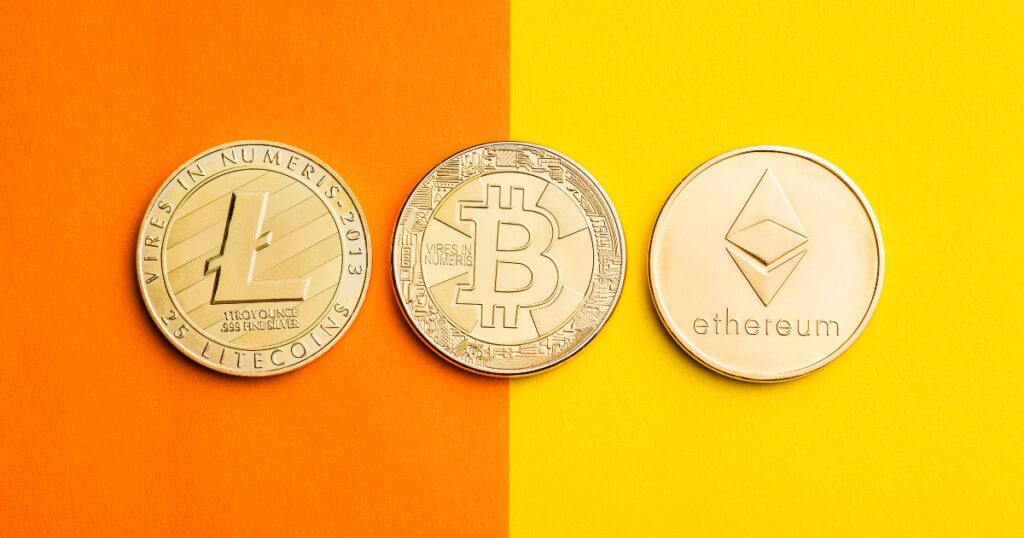It is natural for Bitcoin to cross your mind while reading the word “cryptocurrency,” as it is the first decentralized cryptocurrency. However, there are more than 13 thousand cryptocurrencies, yet Altcoin vs Bitcoin are mostly known by people around the world. To clarify, cryptocurrency is digital money that does not require a bank or financial institution to verify transactions.
The U.S. cryptocurrency market is projected to reach US$9.4bn in 2025. To clarify, people in the U.S. are deeply invested in using Altcoin and Bitcoin for financial growth. But you might be thinking what are those and their roles as digital money? This blog throws light on the differences between these two buzzing cryptocurrencies.
What is Bitcoin?
Bitcoin (BTC) was introduced to the world around 2008–09 by an anonymous entity named Satoshi Nakamoto. This document outlined a revolutionary way of transacting without the need for a central authority like a bank. As it removes the need for trusted third parties, there are 28% of the total U.S. population using Bitcoin at present. Additionally, it was created to provide an alternative to the traditional banking system and offer financial inclusion to people who lack access to conventional financial services.
BTC relies on blockchain technology because it is a distributed ledger that records all transactions across a network of computers. Additionally, a blockchain is formed by adding a chain of previous transactions right after the BTC transaction is verified and stored in the block. Even though the supply of bitcoin is limited to 21 million coins, it is yet a deflationary asset. It is scarce, but one of the most demanding cryptocurrencies in the market.
What is Altcoin?
In simple words, Altcoins refer to all kinds of cryptocurrencies except Bitcoin. There are more than 20 thousand altcoins in the market. These coins do follow the blockchain fundamentals of BTC, but with diverse variations that create a difference between Altcoin vs Bitcoin. Different altcoins that are available in the markets are Myth, Etherum, Solana, Tether, Bianace, and more.
Among many Altcoins, Ethereum is the most used Altcoin in the USA. More specifically, 16% of the U.S. adult population has already invested in alternative cryptocurrency. Additionally, there are two types of alternative coins. While one of them possesses features similar to Bitcoin, the other one works under a different blockchain. Here we can take Ethereum as an example of the second category that works under the blockchain, like DApps and smart contacts. Some Altcoins are also designed to focus on speed, scalability or privacy. However, others might aim to serve as a platform for smart contracts and decentralized applications.
Bitcoin Vs Altcoin: Know the Differences
Now that we are quite familiar with Altcoin and Bitcoin, it is time to know the actual differences based on their features and uses. Let’s dive into the differences between these two cryptocurrencies.
1. Market Capitalization and Popularity
Bitcoin: Being the first cryptocurrency, it is widely used in the marketplace. With high market capitalization, BTC represents more than 40% of the total cryptocurrency market cap. Because of its early market capitalization, Bitcoin is often referred to as “digital gold” and also viewed as a store of value.
Altcoin: When it comes to alternative cryptocurrency, diverse options are available in the marketplace. Even though it has smaller market capitalization, some of them have gained significant traction in the marketplace. Altcoins cannot match the dominance of BTC, but there are many investors who diversify their portfolios by investing in them.
2. Purpose and Use Case
Bitcoin: The main purpose of creating Bitcoin is to eliminate the need for central authorities such as banks and government. BTC supports peer-to-peer transactions between decentralized networks and users. The use of this cryptocurrency means one can make payments across borders without any central authority. It acts as a store of value and medium of exchange, eliminating the cost of the cross-border transaction fees.
Altcoin: As there are many Altcoins, every coin has its own purpose and use. For example, some Altcoins like Bitcoin Cash and Litecoin aim to improve the scalability of Bitcoin. Because Altcoins often follow Bitcoin’s price trends, both upwards and downwards, that influence the scalability. However, other Altcoins like Ethereum provide platforms for smart contracts. Altcoins also play an important role in addressing some problems that Bitcoins cannot solve. For example, Bitcoin can process a limited number of transactions but Altcoins can perform numerous transactions faster in a short time period.
3. Transaction Speed and Fees
Bitcoin: The transaction speed of Bitcoin generally varies and takes around 10-60 minutes to complete. Bitcoin’s scalability is limited as the network process takes around 7 transactions per second (TPS). Additionally, 1 BTC currently costs $87,606.85, which represents a change of +2.63% in the last hour and a change of +3.18% in the last 24 hours. In other words, the Bitcoin price is volatile—changes happen every minute.
Altcoin: Many altcoins have been created to address Bitcoin’s scalability and speed limitations. For example, Litecoin can process up to 56 transactions per second, whereas Ripple is known for handling 1,500 transactions per second. Additionally, there are some other Altcoins that offer lower transaction fees, making them more attractive for smaller transactions or micropayments.
4. Supply and Inflation
Bitcoin: The BTC is limited to supply up to 21 million coins, creating scarcity, which is one of the main reasons for users to view it as a valuable cryptocurrency. It has a deflationary nature that can help preserve purchasing power over time. If we talk about inflation, Bitcoin is automatically reduced by 50% every four years, which gradually decreases its inflation rate. Therefore, it becomes beneficial for investors to invest in Bitcoin.
Altcoin: There are many Altcoins that do not have fixed supply, and their issuance is determined by specific protocols or governance structures. For this reason, Altcoins remain more inflationary than Bitcoin.

